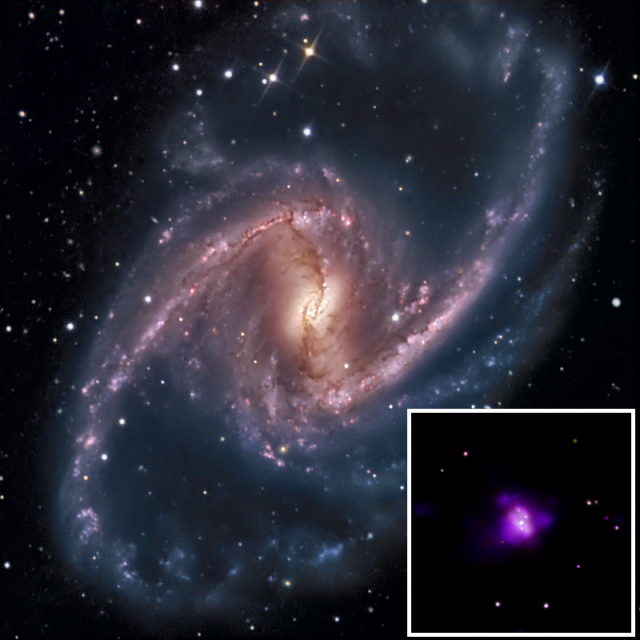
NGC 1365, the Great Barred Spiral Galaxy, in visible light and X-rays (inset). Astronomers determined the strong X-ray emissions from the black hole at the center of this galaxy are due in part to reflection off gas moving nearly at the speed of light.
The space near black holes is one of the most extreme environments in the Universe. The bodies' strong gravity and rotation combine to create rapidly spinning disks of matter that can emit huge amounts of light at very high energies. However, the exact mechanism by which this light is produced is uncertain, largely because high-resolution observations of black holes are hard to do. Despite their outsized influence, black holes are physically small: even a black hole a billion times the mass of the Sun occupies less volume than the Solar System.
A new X-ray observation of the region surrounding the supermassive black hole in the Great Barred Spiral Galaxy may have answered one of the big questions. G. Risaliti and colleagues found the distinct signature of X-rays reflecting off gas orbiting the black hole at nearly the speed of light. The detailed information the astronomers gleaned allowed them to rule out some explanations for the bright X-ray emission, bringing us closer to an understanding of the extreme environment near these gravitational engines.
Despite the stereotype of black holes "sucking" matter in, they attract it via gravity. That means stars, gas, and other things can fall into orbits around black holes, which may be stable for long periods of time. Gas often forms accretion disks and jets that release huge amounts of energy in the form of light. This energy can include X-ray emissions. So despite their name, black holes can be very luminous objects.
Nearer the boundary of a rotating black hole—its event horizon—the strength of gravity is such that the space matter occupies can be also dragged around the black hole. This effect is called "frame dragging," and is predicted by Einstein's general theory of relativity. The region in which frame dragging becomes significant, however, is very close to the black hole's event horizon, which is relatively small, especially when imaged from Earth. As a result, astronomers could not be sure whether ordinary orbital effects or relativistic frame-dragging is more important for producing the intense X-ray emissions.
Astronomers paid particularly close attention to the supermassive black hole at the center of the Great Barred Spiral Galaxy (also known by its catalog number NGC 1365) when a cloud of gasmomentarily eclipsed it. That rare event allowed them to get a good size estimate for the accretion disk that surrounds the black hole. The current study followed up by monitoring fluctuations in the X-ray emissions, using the orbiting XMM-Newton and NuSTAR X-ray telescopes.
In particular, the researchers looked at emission from neutral and partly ionized iron atoms in the gas. Prior observations showed that the emission lines were broadened, which can be caused by several different phenomena. Researchers considered two primary hypotheses: absorption by other gas along the line of sight between the black hole and us, or very fast motion of the gas itself.
The new data strongly supported the latter option. In this scheme, the observed X-ray light reflected off the inner edge of the accretion disk, where the gas is moving at very close to the speed of light. According to the models, this scattering occured well within the frame-dragging region near the black hole. The inner edge of the accretion disk may be close to or at the minimum stable distance from the black hole. Closer than that distance, and matter can no longer orbit in a circular path—it will tend to spiral in.
The authors argued that any explanation of the X-ray emission that fails to account for the general-relativistic effects just won't work. Previous observations estimated that the black hole in the Great Barred Spiral Galaxy is spinning nearly as fast as possible; whether other black holes will have similar properties remains an open question.
I also tested them by indexing massive quantities of documents (inside millions) under a
ReplyDeletehuge selection of domain names. Many internet search engine marketers pay market value for keyword placement when the market price drives them directly to a
negative margin. A tiny bit of magic and a tiny bit of perl was in a position to generate a
similar reports in 45 minutes simply by feeding a similar logs into both systems before the results came out
the identical and every condition was accounted for.
my site - review of proxy goblin